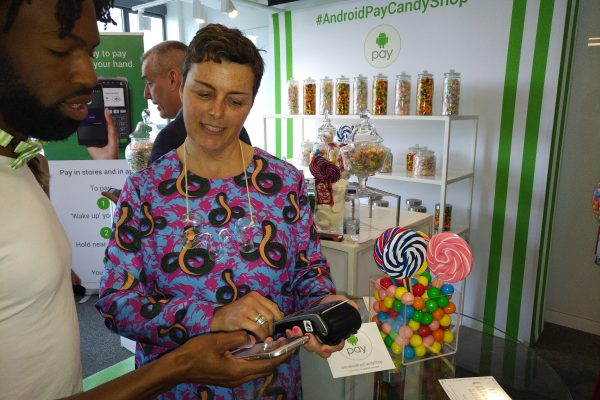Android Pay launched in Canada on Wednesday, with support from three of the five major banks and support for both credit and debit cards announced.
Android Pay is starting its rollout to the Canadian market with ATB Financial, BMO, Canadian Tire, CIBC, Desjardins, National Bank, PC Financial, Scotiabank, and Tangerine. It will be using the tokenization services offered by Visa, Mastercard, and Interac here to authenticate payments, with support for Interac cards expected to go live June 5.
Android Pay debuted in the U.S. in September of 2015 and is seeing adoption at a pace of 1.5 million new registrations per month. Worldwide, it’s accepted in more than 2 million locations. Google expects that adoption in Canada could show an even steeper hockey stick curve on the adoption graph.
“Users are looking to get more out of their mobile devices and that’s why we’re bringing these services to the Canadian market,” says Spencer Spinnell, the head of emerging platforms at Google Inc. “The U.S. is a fragmented eco-system, Canada, on the other hand, is much more sophisticated. You’ve enjoyed contactless payments for awhile.”
Speaking to a room of journalists via video conference from his Silicon Valley office, Spinnell said Google has been interested in launching to the Canadian market from the start of Android Pay. But technology integration takes time, he says.
There’s a long list of well-known Canadian retail brands that Google describes as launch partners, from Loblaws, to Sears, to Chapters Indigo. Those are promotional partners to help advertise Android Pay’s availability, as any merchant that can accept contactless payments will be able to accept Android Pay. No set up required.
At Toronto’s The Candy Bar, store owner Paola Giavedoni has been using a Moneris POS that supports contactless payment since she opened shop. She looks forward to accepting Android Pay as well, saying it can be more convenient than using cash.
“Our transaction is now more about me and you and what you are buying and what you want, and not about the financials, which is great,” she says. “If you want to buy something from my shop, I want to find something that makes you happy when you walk out the door. How you pay for it doesn’t matter.”
Giavedoni notices more customers using their phones as a payment option in store. Apple Pay has been broadly supported by banks in Canada since May 2016 and some banks have offered mobile payments functionality on their own Android apps over the past couple of years.

Moneris, the most popular POS provider for Canadian merchants, says that one in three of all its transactions processed are now contactless. It predicts that will grow to half of transactions by the end of 2017 because of Canadians’ adoption of mobile wallets. It also says that of 18-34 year-olds, one quarter say they prefer to pay with a mobile wallet.
About 85 per cent of Moneris’ 350,000 merchants can accept Android Pay with the contactless payments terminals they already use, according to Moneris.
Sanjay Gosalia, the head of financial services at Google Canada, says Google worked collaboratively with its bank partners and networks to launch in Canada.
TD and RBC are notably absent from the launch, but expected to begin offering support in the next couple of quarters. Google says that more technical integration is required for those banks.
Google doesn’t charge transactions fees for Android Pay. It doesn’t disclose the deals it makes with banks for the service either. But for merchants, they can expect the same sort of transaction fees for a credit card used via Android Pay tokenization as they would as if it were used directly.
Android Pay requires a phone with NFC and running Android 4.4. To use it, users just have to set up their payment credentials on their device. After that, they should be able to turn on their phone near any contactless terminal and it will detect it and make a payment under $100 without need for unlocking. For transactions more than $100, users will need to unlock their device.
Android Pay differs from Apple Pay, which requires users authenticate each transaction with a fingerprint. Google says that if users lose their phones, they can use Android Device Manager to lock their devices, to prevent them from being used to make purchases.
Another minor difference from Apple Pay – Apple Pay generates the payment token on the device in the Secure Element. Android Pay generates that token with a cloud service.
Implications for Google Home launch in Canada
In our review of using Google Home without it being officially supported in Canada, we mentioned that shopping is one of the few things that Canadians can’t do with it right now. The problem is that Google will only accept U.S. credit cards as payment.
With Android Pay launching in Canada, Google will now accept Canadian-based credit cards (and soon debit cards) as payment methods. In theory, that should mean that Google Home users will be able to select that as a payment option within the Google Home app. (This is how it works according to an American user).
Currently, if you’re using Google Home in Canada, the payment methods option is hidden from the Google Home settings menu. But when the device is launched in Canada officially later this summer, as announced at Google I/O, it’s possible that launch will include a shopping capability.
Google says it’s not commenting on what the Canadian launch of Google Home will look like yet, in terms of services supported.
Thanks for your interest, Brian! We have no updates or announcements to share at this time.
— Made By Google (@madebygoogle) May 31, 2017





